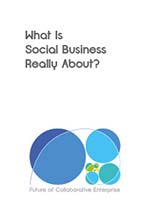Every time I hear or read the word “brand” associated with “social”, I wince. Not because of the ballooned hype surrounding this kind of association, but because most of this hype reveals an outdated – and often damageable – vision of what “marketing” and “brand” mean in our highly networked context. I won’t hold forth about marketing, as Greg Statell (@Digitaltonto) recently thoughtfully and thoroughly nailed this coffin, but ‘brands’ have a story to tell, nevertheless quite different from what ‘social media marketers’ (sigh) are trying to teach us.
The evolution of branding
Even if brands existed long before, ‘modern’ branding is a typical emergence from industrial era and mass consumption. Mass consumption went de pair with mass production, and at that time, brands were a necessary differentiating feature for otherwise quite similar products competing with each other in crowded categories. While already meant to leverage customers’ loyalty, brands were tools directly linked to the products they were apposed to and to their (sometimes supposed) tangible qualities. In other terms, brands were the intermediary layer through which companies pushed products, and communication, toward customers: know me better, and you will buy me more.
Brands’ meaning, and our comprehension of their signification, changed over time, from company-created (consciously conveying facts and values attached to products) to customer-owned (constructed in customers’ mind along their experience with products, according to their perception of the values conveyed through interaction with the company). A great reading about this evolution is the analysis made by Steve Vargo, Yi He and Michael Merz in “The evolving brand logic: a service-dominant logic perspective“.
People, not brands
Employees and communities of customers are also considered as integral actors in brands’ value creation. Brands acquired new dimensions through human resources and societal responsibility. Nevertheless, the same paradigm still prevails: brands as a filter through which companies, customers and their respective ecosystems and networks communicate and create value. As interactions and conversations now matter more than individual behaviors, and as we begin to understand how and how much they influence them, this conception is no more relevant.
Interactions are a human-to-human matter, they involve people, not brands. Whether it be a customer service rep, a sales person, a community manager, another customer, a relative, conversations and engagement are always about exchanging knowledge between different human beings. Period. Nobody, unless irremediably harebrained, has ever conversed with a brand. In that context, talking about brand engagement or online presence is pure nonsense.
From filters to attractors
Brands have no more reason to stay in the way between people. I previously envisioned brands as strange attractors in the complex system formed by companies, customers and their relative ecosystems, and this is something I want to further explore here.
Brand value creation happens through knowledge sharing and use: knowledge about how a product or service fits into customers’ job-to-be-done (value created through experience in use), knowledge about collected customers’ insights, knowledge created and collected through all available kinds of human interactions (at company-customers touchpoints, between different stakeholders,…). The factual, informative part of shared knowledge is directly related to these interactions, but as brands are no more a screen between people, is it still relevant to consider it as part of their value? Beyond information and context, emotional intent is a capital factor of knowledge, since no sharing would ever take place without this intent. This emotional dimension is, in fact, what constitutes today the value of brands.

The emotional dimension of knowledge sharing
Differentiating emotion from information and context is, of course, not an easy task. But viewing brands from such a prism provides us with thoughtful insights in understanding how value is co-created and how brands could help in maximizing this value, both for customers and companies. Valeria Maltoni (@ConversationAge) wrote sometime ago a thought provoking post entitled “Why Customer Service in Social is not Fair“. She made some great points in it, but let us consider the case under our new prism:
- Company-customer interaction
Complaining online provides the company with knowledge about an existing issue. This is directly actionable knowledge, which can be used to fix some broken process, for the benefit of all customers. Whether the company chooses to use it or not is another story, but not using it might prove to be expensive, as Valeria wrote.
On exchange of this knowledge, the company rewards the customer with direct resolution of his issue. Is that unfair? I don’t think so. - Brand value
On an emotional point of view, this interaction modifies the customer’s perception of the brand. It raises his level of satisfaction, and potentially turns him into a brand’s advocate. It is a win-win situation.
Emotional intent is intrinsic to knowledge sharing. Brands, as emotional attractors, facilitate and foster further communication between companies and customers, and their value is created on the go, through customers’ expectations and level of satisfaction, through companies’ commitment to provide better customer experience, through day-to-day experience of every internal or external conversation. Communities are glued by shared emotional values, and brands are the signals which allow further, actionable, conversations to take place in them.
Awareness, influence, advocacy, trust and loyalty are powerful dynamics of emotion which shape brands value. Analytics, crowdsourcing, interaction, are some of the levers which companies should use to enhance business through the social web, and which build more brand value along the way. Talking about “brand presence on social media”, thinking “brand” instead of “company” is a serious error, as well as Social CRM is neither a fans counter nor a social media listening tool, but an extension to CRM. Clay Shirky qualified as “Cognitive Surplus” the spare part of human creativity which can be used to help in building a better life. Similarly, I see brands as “Emotional Surplus”: the emotional dimension of knowledge sharing which can be used to help in providing better user experience.






Very interesting post. We at eYeka experience it when we see how delighted our clients (companies) are to see creative consumers (consumers) re-interpret their brands (brand) in very diverse way. Check it out on http://en.eyeka.com/
Last precision: I think Clay Shirky dubbed it “Cognitive Surplus”, even though it’s mainly about creativity 😉
Thanks Yannig, I have corrected my acte manqué 😉
I agree with you: re-interpretation is appropriation, which fully engages the emotional dimension. But… “Are you a brand”… Really?
Do you say that because I linked my name to the eYeka website? I am definitely not a brand, that’s why I also think the term “personal branding” is nonsense!
LOL!! No, I don’t, this is on your website menu 😉
Pingback: Harold Jarche » Friday’s Finds: teaching ourselves